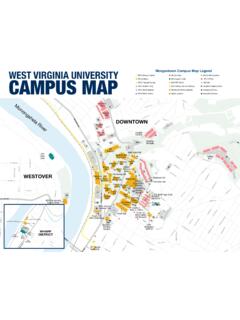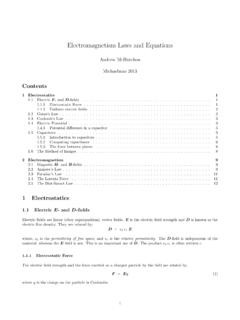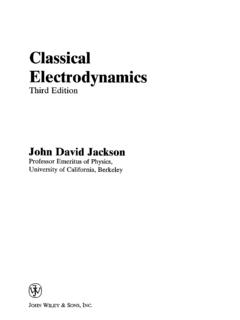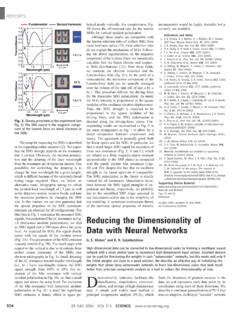Transcription of Deriving relativistic momentum and energy - arXiv
1 Deriving relativistic momentum and energy Sebastiano Sonego and Massimo Pin . arXiv :physics/0402024v3 [ ] 15 Sep 2004. Universita di Udine, Via delle Scienze 208, 33100 Udine, Italy June 24, 2004; LATEX-ed February 2, 2008. Abstract We present a new derivation of the expressions for momentum and energy of a relativistic particle. In contrast to the procedures commonly adopted in text- books, the one suggested here requires only the knowledge of the composition law for velocities along one spatial dimension, and does not make use of the concept of relativistic mass, or of the formalism of four-vectors.
2 The basic ideas are very general and can be applied also to kinematics different from the Newtonian and Einstein ones, in order to construct the corresponding dynamics. PACS: +p; ; +b Keywords: relativistic energy ; relativistic momentum ; relativistic dynamics. 1 Introduction Every physics student knows that, in Newtonian dynamics, a particle with mass m and velocity u has a momentum p = mu ( ). and a kinetic energy 1. m u2 . T = ( ). 2. Usually, she does not stop to worry why these quantities are defined just by Eqs. ( ) and ( ), and not by other functions such as, , mu/2, mu2 u, or 3mu4.
3 This comfortable situation ends when she attends a first course in Einstein dynamics. The expressions for momentum and kinetic energy , mu p= q ( ). 1 u2/c2. and m c2. T =q m c2 , ( ). 2. 1 u /c 2.. 1. Deriving relativistic momentum and energy 2. now look so unnatural that she wonders about the reasons for choosing such complicated functions of velocity. At this point she can find, basically, three kinds of justifications for the expressions ( ) and ( ) in textbooks dealing with relativistic dynamics at an introductory level: 1. Requiring momentum conservation in all inertial frames for an elastic collision where particles are deflected from their initial line of flight [1].
4 Within this approach, the discussion is not entirely trivial, because of the two-dimensional character of the process. Also, it seems odd that one need invoke a second space dimension at all. What happens if we restrict ourselves to study motion along a straight line? There ought to be a way to find p and T without going outside in the second dimension. 2. Requiring momentum conservation for a head-on elastic collision together with con- servation of a relativistic mass [2]. This circumvents the previous difficulty, but the use of a relativistic mass, and the pedagogical value of such a concept, have been strongly criticised [3].
5 (However, see Ref. [4] for different opinions about this issue.) Of course, what is used in this approach is actually conservation of energy E (equal to T + m c2 ), but why then should one assume that p = Eu/c2 , as done implicitly by the authors in Ref. [2]? 3. Working with four-vectors, so one defines four- momentum just in the same way as the three- momentum of Newtonian theory, but with three-velocity replaced by four- velocity [5]. The problem here is that there is no guarantee, a priori , that such a quantity will be conserved for an isolated system. Indeed, the conservation law is usually checked for the case of a simple elastic collision, after four- momentum has been defined.
6 Also, this approach requires the introduction of radically new ideas, hence it is unsuitable for a conceptually elementary presentation of the theory. There is a fourth approach, which to our knowledge has never been adopted in text- books,1 that resembles 1 above but is cleaner and can be consistently applied even in one space dimension only. It is based on the remark that, if energy is conserved in all inertial frames, then something else is also conserved. In the non- relativistic regime, this something else turns out to coincide with linear momentum . We suggest doing the same at the relativistic level.
7 We believe that this is the best strategy to adopt in an introductory course, be- cause it relies on the same physical concepts that students are already familiar with from Newtonian mechanics, and does not introduce any new notion like relativistic mass or four-vectors. It focusses on similarities, rather than differences, between Newtonian and Einstein dynamics. Hence, a student is not required to replace physical pictures and mathematical tools with other, quite different ones minor adaptations are enough, the general scheme remaining the same. Furthermore, the approach we suggest casts light not only on the expressions ( ) and ( ) for momentum and energy in special relativity, but on ( ) and ( ) in Newtonian mechanics as well.
8 Indeed, the underlying philosophy is that energy and momentum are nothing else than functions of mass and velocity that, under suitable conditions, happen 1. Actually, the idea has not been totally ignored; see, , Ref. [6]. However, its extant implementations are not as simple as they could, making use of two-dimensional scattering and four-vectors. Deriving relativistic momentum and energy 3. to be conserved. This is why we treat in a special way those functions, rather than others. This point of view deserves to be emphasised in a pedagogical exposition, because it provides clear insights on the reasons why momentum and energy are defined the way they are, at the same time demystifying their meaning.
9 Our starting point is the definition of kinetic energy for a particle, as a scalar quantity whose change equals the work done on the particle. Mathematically, one first defines the power (work per unit time). W := F u , ( ). where F is the total force acting on the particle. Then, using Newton's second law dp =F , ( ). dt which holds both in the non- relativistic and in the relativistic regimes, one gets also dp W = u . ( ). dt Finally, one defines a function T (u) such that dT. := W ( ). dt (this is possible since using Newton's second law we have equated power to a purely kinetic quantity), thus obtaining dT = u dp.
10 ( ). In the following, we shall adopt Eq. ( ) as a fundamental relationship between kinetic energy and momentum , that stands up on its own, independently of any justification like the one based on Eqs. ( ) ( ). For a system of non-interacting particles, kinetic energy is necessarily additive, since work is. We are then ready to introduce the two physical postulates upon which our discussion is based: P1. The principle of relativity;. P2. The existence of elastic collisions between asymptotically free particles. As we shall see, from these ingredients it follows that in an elastic collision, there is another quantity that is conserved a vector one, that we identify with momentum .
![arXiv:0706.3639v1 [cs.AI] 25 Jun 2007](/cache/preview/4/1/3/9/3/1/4/b/thumb-4139314b93ef86b7b4c2d05ebcc88e46.jpg)

![arXiv:1301.3781v3 [cs.CL] 7 Sep 2013](/cache/preview/4/d/5/0/4/3/4/0/thumb-4d504340120163c0bdf3f4678d8d217f.jpg)
![@google.com arXiv:1609.03499v2 [cs.SD] 19 Sep 2016](/cache/preview/c/3/4/9/4/6/9/b/thumb-c349469b499107d21e221f2ac908f8b2.jpg)











